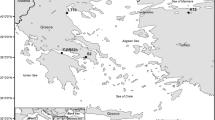Abstract
Six sediment cores collected from the Northwestern Arabian/Persian Gulf have been radiometrically dated by 210Pb. Three cores were collected from stations within the Kuwait Bay, and three others were collected from stations outside the bay. Two models have been used for 210Pb dating of sediment cores, i.e. Constant Flux: Constant Sedimentation (CF:CS) Model and the Constant Rate of Supply (CRS) Model. The average rates were found to vary significantly between 0.16 and 1.00 cm y−1 for stations outside and within the bay respectively. The variability of the sedimentation rate was essentially physiographic characteristics and variable hydrodynamic condition. In this study, 137Cs fallout radiotracer was also used to construct a realistic chronology. It was observed that the 137Cs in the entire vertical profile has been continuously contributed by fluvial and atmospheric deposition.




Similar content being viewed by others
References
Uddin S, Ghadban ANA, Khabbaz A (2011) Localized hyper saline waters in Arabian Gulf from desalination activity an example from South Kuwait. Environ Monit Assess 181(1–4):587–594
Al Ghadban A, Uddin S, Aba A, Behbehani M (2010) Measurement and assessment of radionuclide concentrations in the coastal marine environment. Kuwait Institute for Scientific Research (KISR) 9946:1–25
Al-Abdali F, Massoud M, Al-Ghadban A (1996) Bottom sediments of the Arabian Gulf III. Trace metal contents as indicators of pollution and implications for the effect and fate of the Kuwait oil slick. Environ Pollut 23:285–301
Al-Ghadban A, Massoud M, Abdali F (1996) Bottom sediments of the Arabian Gulf: sedimentological characteristics. Kuwait J Sci Eng 23:71–88
Massoud M, Al-Abdali F, Al-Ghadban A, Al-Sarawi M (1996) Bottom sediments of the Arabian Gulf II. TPH and TOC contents as indicators of oil pollution and implications for the effect and fate of the Kuwait oil slick. Environ Pollut 93(3):271–284
Metwally M, Al-Muzaini S, Jacob P, Bahloul M, Urushigawa Y, Sato S, Matsmura A (1997) Petroleum hydrocarbons and related heavy metals in the near-shore marine sediments of Kuwait. Environ Int 23:115–121
Al-Zamel A, Bou-Rabee F, Olszewski M, Bem H (2005) Natural radionuclides and 137Cs activity concentration in the bottom sediment cores from Kuwait Bay. J Radioanal Nucl 266:269–276
Bem H (2006) Determination of the sediment deposition rates in the Kuwait Bay using 137Cs and 210Pb. Nukleonika 51(Suppl 2):S39–S44
Goldberg ED (1963) The sea: ideas and observations on progress in the study of the seas. In: Hill, M.N. (Ed) The oceans as a chemical system. vol 2. The composition of seawater and Comparative and descriptive oceanography. Wiley, New York
Appleby P, Jones V, Ellis-Evans J (1995) Radiometric dating of lake sediments from Signy Island (maritime Antarctic): evidence of recent climatic change. J Paleolimnol 13:179–191
Walling D, He Q (1999) Using fallout lead-210 measurements to estimate soil erosion on cultivated land. Soil Sci Soc Am J 63:1404–1412
Walling D, He Q, Blake W (1999) Use of 7Be and 137Cs measurements to document short-and medium-term rates of water-induced soil erosion on agricultural land. Water Resour Res 35:3865–3874
Zapata F, Garcia-Agudo E, Ritchie JC, Appleby P (2003) Chapter 1: Introduction. In: Zapata F (ed). Springer, Amsterdam, pp 1–13
Al-Ghadban A, Uddin S, Beg M, Al-Dousari A, Gevao B, Al-Yamani F (2008) Ecological consequences of river manipulations and drainage of Mesopotamian marshes on the Arabian Gulf ecosystem: investigations on changes in sedimentology and environmental quality, with special reference to Kuwait Bay. Kuwait Institute for Scientific Research (KISR) 9362:1–141
Uddin S, Al-Ghadban A, Gevao B, Al-Shamroukh D, Al-Khabbaz A (2012) Estimation of suspended particulate matter in Gulf using MODIS data. Aquat Ecosyst Health Manage 15(S1):41–44
Neelamani S, Uddin S (2013) Erosion and Accretion Index for Kuwaiti Coast. Int J Environ Res 7(3):679–684
Corcoran MK (2007) Geomorphic identification and verification of recent sedimentation patterns in the Woonasquatucket River, North Providence, Rhode Island http://oai.dtic.mil/oai/oai?verb=getRecord&metadataPrefix=html&identifier=ADA464865. Accessed 21 Nov 2013
Crickmore M, Tazoli G, Appleby P, Oldfield F (1990) The use of nuclear techniques in sediment transport and sedimentation problems. UNESCO
Appleby PG (2002) Chronostratigraphic techniques in recent sediments. In: Last W, Smol J (eds). Springer, Netherlands, pp 171–203
Appleby P, Oldfield F (1992) Application of lead-210 to sedimentation studies. Uranium-series disequilibrium: applications to earth, marine and environmental sciences. Clarendon Press, Oxford, pp 731–778
Oldfield F, Appleby P (1984) Empirical testing of 210Pb-dating models for lake sediments. In: Haworth EY, Lund JWG (eds) University of Minnesota. Minneapolis, Mn, pp 93–124
Appleby P, Oldfield F (1978) the calculation of lead-210 dates assuming a constant rate of supply of unsupported 210Pb to the sediment. Catena 5(1):1–8
Aba A, Ismaeel A (2013) Preparation of in-house calibration source for the use in radioactivity analysis of the environmental samples: consideration of homogeneity. J Radioanal Nucl 295(1):1–10
Shakhashiro A, Tarjan S, Ceccatelli A, Kis-Benedek G, Betti M (2012) IAEA-447: a new certified reference material for environmental radioactivity measurements. Appl Radiat Isot. doi:10.1016/j.apradiso.2012.01.024
Al-Ghadban A (1990) Holocene sediments in a shallow bay, southern coast of Kuwait, Arabian Gulf. Mar Geol 92(3–4):237–254
UNSCEAR (2000) Sources and effects of ionizing radiation: Sources Annex C: exposures to the public from man-made sources of radiation
Acknowledgments
The authors wish to thank the Kuwait Foundation for the Advancements of Sciences (KFAS) for their financial support. The authors also wish to express their gratitude to Dr. Naji M. Al-Mutairi, Director General for his support. The authors deeply thank Anfal Ismaeel for her contribution in sample preparation and measurements. Special thanks go to Dr. M. Quine, the senior researcher at KISR for his valuable comments and discussion.
Author information
Authors and Affiliations
Corresponding author
Rights and permissions
About this article
Cite this article
Aba, A., Uddin, S., Bahbahani, M. et al. Radiometric dating of sediment records in Kuwait’s marine area. J Radioanal Nucl Chem 301, 247–255 (2014). https://doi.org/10.1007/s10967-014-3140-z
Received:
Published:
Issue Date:
DOI: https://doi.org/10.1007/s10967-014-3140-z




